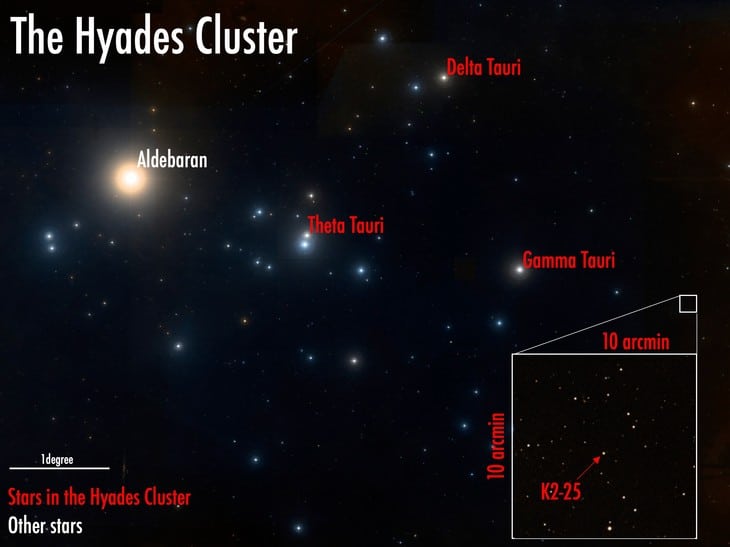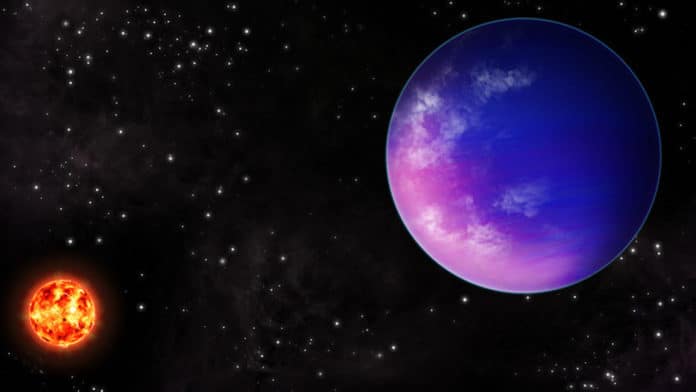Using radial-velocity data from the Habitable-zone Planet Finder, astronomers at the Penn State have characterized a young planet named K2-25b. The planet is slightly smaller in size than Neptune and orbits an M-dwarf star.
Astronomers characterized the planet’s mass, radius, and the tilt of its orbit.
The planet was originally detected using the Kepler spacecraft by observing a dip in the host star’s light caused by the planet crossing in front of — or transiting — the star and blocking some of the star’s light during its orbit; a trip completed every 3.5 days. The planetary system is a member of the Hyades cluster, a nearby cluster of young stars with similar chemical properties that formed about 600 million years ago about 150 light-years away from Earth.
Gudmundur Stefansson, lead author of the paper, and a former doctoral student at Penn State who is currently a postdoctoral fellow at Princeton University, said, “K2-25b is one of the very few young planets orbiting a low-mass star with a measured mass and orbital tilt. Although smaller in size than Neptune, the planet interestingly has a mass of about 1.5 times larger than Neptune. The planet is dense for its size and age, in contrast to other young short-period sub-Neptune systems which are often observed to have low densities and extended evaporating atmospheres.”
The tilt of planetary orbits encodes valuable information on how planetary systems form and evolve. Studying the star’s spectra is one of the effective ways to measure the tilt of planetary orbits.

As the host star is rotating during a planetary transit, one half of the stellar disk is “blueshifted” — its light spectrum shifts toward shorter wavelengths—as seen from the observer, while the other half of the star is “redshifted” — a shift toward longer wavelengths. As the planet passes in front of different regions of the stellar disk, it blocks differently blue- and red-shifted light, causing anomalous variations in the velocity of the star. By carefully measuring these velocity changes, the tilt of the orbit can be inferred.
Suvrath Mahadevan, professor of astronomy and astrophysics at Penn State, said, “K2-25b’s orbit is well aligned with the host star’s equator, giving insights into how planetary systems around low-mass stars form. Only three other planetary systems orbiting low-mass stars have had their orbital tilts measured. By leveraging the large 10m aperture of the Hobby-Eberly Telescope and HPF’s sensitivity at near-infrared wavelengths — where low-mass stars emit most of their light — we are excited to conduct similar observations of other M-dwarf planetary systems to study further how they form and evolve.”
For the study, astronomers used additional data obtained with the 3.5m Telescope at Apache Point Observatory in New Mexico, and the 0.9m Telescope at the Kitt Peak National Observatory (KPNO) in Arizona. They used a photometric technique and instrumentation called diffuser-assisted photometry.
Jayadev Rajagopal, the astronomer at the National Science Foundation’s NOIRLab, said, “The high-accuracy photometry from the 0.9m WIYN Telescope using the innovative diffuser technique is an important part of this study that allowed us to define the shape of the transit better and thereby further constrain the size, density, and composition of the planet. Smaller aperture telescopes, when equipped with state-of-the-art (but not expensive) equipment, can be platforms for high impact science programs. Very accurate photometry will be in demand for exploring host stars and planets in tandem with space missions and larger apertures from the ground, and this is an illustration of the role that a 0.9m telescope can play in that effort.”
This research was supported by the U.S. National Science Foundation (NSF), Penn State, the Heising-Simons Foundation, the NASA Earth and Space Science Fellowship program, the Center for Exoplanets and Habitable Worlds at Penn State, and the Research Corporation.
Journal Reference:
- Gudmundur Stefansson et al. The habitable-zone Planet Finder Reveals A High Mass and a Low Obliquity for the Young Neptune K2-25b. arXiv:2007.12766
